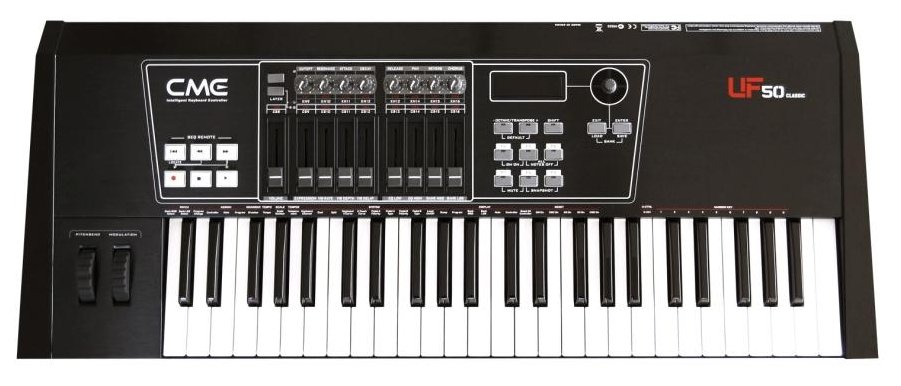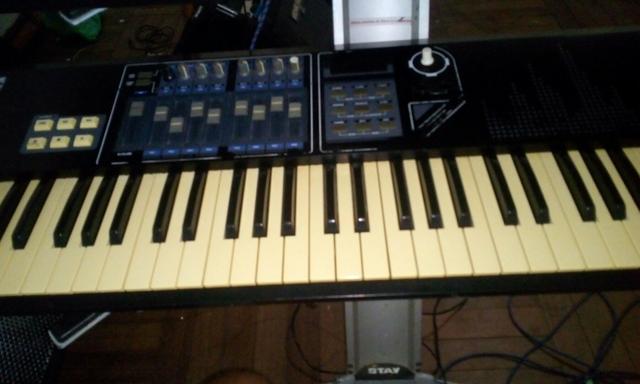
Cme Uf Series Midi Keyboard Driver For Mac Os X
The bright, jangling tones of an acoustic guitar fit in with almost any instrument, sound beautiful on their own and are a perfect accompaniment for the human voice. But where did it come from, and how do you know which is right for you? Musician's Friend has a wide assortment from the biggest acoustic guitar makers around as well as smaller, more niche brands. We've got everything from affordable entry-level starter packs for younger players to highly detailed one-off guitars for gigging professionals and collectors. A Brief History of the Acoustic Guitar You may be surprised to know the acoustic guitar's roots go back to Ancient Egyptian. A lute was a hollow-bodied wood instrument with multiple strings attached to a soundboard via a thin piece of wood (the bridge).
This version driver is compatible with Windows XP 32/64 bit OS and Windows Vista 32/64. UF400e V1.21b Driver for Mac OSX. Just unzip the file,then run CME-UF-MIDI-1.2u.pkg to install the driver. Driver 1.1.0 for UF series [MAC OSX]. M-Key is class compliant for both Windows and Mac (Vista/XP and OS X). The CME U-Key Mobiletone keyboard, which is also available in White and Blue, has ultra-slim, full-action semi-weighted keys, a built-in 64-polyphony high-quality sound module and an internal, high-fidelity speaker driven by a digital amplifier. CME Keyboards, MIDI.
The strings were stretched in a parallel fashion across a soundhole, and wound taut to a peg or post (tuners) atop the neck. The tension of each string was adjusted to create a pattern of frequencies familiar to those who played it. The lute had a teardrop-shaped soundboard, bowl-shaped body and a sharp bend in the neck. A lutist, much like today's guitarist, strummed or plucked the strings with their fingers or a plectrum (what we call a pick). The sound produced was created by the air being moved around the string vibrations, the vibrations coming off the soundboard, and the air resonating back out from the body chamber through a soundhole.
Fingers on the 'neck' hand change the pitch of a string by pressing it firmly against specific spots along the neck top (fingerboard). Though the lute was used through the Baroque era, the inspiration for the name 'guitar' showed up back in 13th century Western Europe with the 'gittern.' Similar in design to the lute, its body was carved out of a single piece of wood and had a smooth or straight neck joint. In the 15th century, Spain introduced the vihuela, a flat-backed, peanut-shaped design with a less pronounced neck bend and pairs of strings tuned in unison.
Roughly 350 years later, Spanish-born guitar maker Antonio Torres Jurado created a larger body design and introduced fan bracing for internal reinforcement. This made what we now call the nylon-string, Spanish or classical guitar, louder with better projection and a cleaner tone. In 1916, C.F.
Martin & Company developed the square-shoulder dreadnought acoustic guitar. Named for the large battleships of the time, it was wider, deeper and yielded more volume, with a rich, well-rounded tone.
Btbit.org 磁力链接搜索引擎,为您提供最好的磁力链接和种子搜索引擎。. Testi po istorii kirgizstana s otvetami 3. 2 0.00% 2 0.00%. /skachat-obrazets-shapki-firmennogo-blanka-konsulstva-kirgizstana.html 1.
Popular with the folk and bluegrass guitarists of the time, it is still the best-selling acoustic guitar shape today. Around that same time, banjo and violin manufacturers experimented with telephone transmitters to amplify the vibrations of the soundboard so guitars could be heard over the louder brass and drum sections of the era's big band setup. As technology evolved, piezoelectric transducers or condenser microphones became the norm for 'picking up' the vibrations of the acoustic soundboard.
A preamp was added to convert the weak electronic signals from the pickup, giving them a boost and sending them to an or amplifier or speaker. The first preamps were limited to simple treble (higher frequency notes) adjustment. Today's more advanced preamps offer onboard tactile control over volume, dynamic equalization, mic blending, and feedback filters and more. Many also come with a tuner to help ensure better-sounding performance.
Finding the Best Acoustic Guitar for You Acoustic guitar makers are always working on ways to improve on those early designs with new body shapes, tonewoods, and other visual appointments they hope will garner your attention. Here's how to tell them apart.
Common Acoustic Body Shapes As stated above, the Dreadnought acoustic is king of the steel string. Its versatile design makes it fit in nicely with any musical style. But there are several other shapes to choose from. The smallest acoustic guitar, the Parlor is a fingerpicker's dream. They're perfect for travel, practicing anywhere, and a favorite of blues, and indie folk players.

With slightly longer bodies, Folk, Concert and Model 'O' acoustic guitars offer a more balanced tone with increased bass response, yet remain travel-friendly. Next up is the Grand Concert ('OO'), which is shaped like a short scale classical guitar with a shallower body, pinched in waist and rounded shoulders. What it lacks in volume, it makes up with better articulation and even-tempered midrange, making them a solid choice for recording. They are also perfect for smaller-handed players. The hourglass figure of the mid-size Orchestra ('OM') or Grand Auditorium ('GA') acoustic guitar offers a good balance of treble and bass, with a well-defined midrange. It’s an excellent all-around option for singer-songwriters with the perfect curve for resting on your leg while sitting.